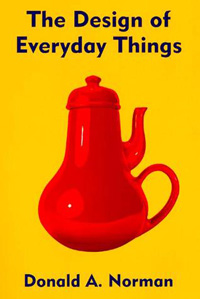
Book Recommendation
Donald Norman’s “The Design of Everyday Things” is currently my commuting book which I’ve had ample opportunity to read because the F train here in NYC is the most capricious multi-ton object I’ve ever encountered. This is a good book if you want a straightforward introduction to basic design principles. Norman is an engineer by training which means he comes from a different tradition than, say, an architect. He goes through all sorts of examples of commonly encountered objects – keyboards, sinks, ovens, telephones – to help demonstrate that good design would benefit from prototyping and user-testing because, in the end, humans are fairly adept at taking clues about how to use an object from their first glance. When things aren’t obvious, it’s the fault of the design, not the fault of the person who has trouble figuring out how to put someone on hold or transfer a call with a phone system that can likely ONLY be used by a robot or an algorithm. He opposes beautiful design for the sake of beauty – glass doors stripped of plates and hand bars in service to the sleek glossiness of glass’s amazing material properties are no good if people end up pushing on the hinged side of the door when they should be pulling on its swinging side.
Norman offers users a set of criteria by which everyday design can be critiqued as well as some rules of thumb for figuring out particularly obtuse design challenges. He absolves humans their occasional mechanical buffoonery, “Humans, I discovered, do not always behave clumsily. Humans do not always err. But they do when the things they use are badly conceived and designed.” Norman doesn’t go so far as to suggest that the objects themselves possess agency, it’s not the fault of the things, but of the people who designed them, “When you have trouble with things…it’s not your fault. Don’t blame yourself; blame the designer. It’s the fault of the technology, or more precisely, of the design.” This part of his theory is the weakest. It’s rather simplistic to blame the designers without interrogating why they produce shoddy designs. He hints that designing for the sake of beauty is part of the problem and that user testing happens in the market place where negative reactions are likely to kill the product line altogether rather than resulting in intelligent, sensitive redesign. Luckily, other books (Harvey Molotch’s “Where Stuff Comes From” for example) do a better job of revealing the motivations and constraints on designers.
Where Norman is at his best is in the many detailed examples of everyday objects gone screwy with clear, diagramatic prescriptions for improvement. Norman never rants about bad design just to sharpen his teeth. His examples are accompanied by constructive suggestions that are so clearly spelled out that readers are capable of critiquing his suggestions, a sure sign that the book succeeds as a teaching tool. Furthermore, Norman illustrates his discussion with photos, sketches and diagrams throughout which enriches the legibility of the project and subtly introduces readers to the practice of learning through drawing that is common in design practice, but not all that common outside of it.
Relevant Resources
Norman, Donald A. (1998) “The Design of Everday Things” Cambridge, MA: MIT Press.
Molotch, Harvey. (2003) Where Stuff Comes From: How Toasters, Toilets, Cars, Computers and Many Other Things Come to Be As They Are. New York: Routledge.

